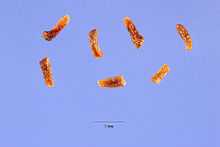Eucalyptus saligna
| Sydney blue gum | |
|---|---|
 | |
| Blue gum forest at Mount Cabrebald, NSW, Australia | |
| Scientific classification | |
| Kingdom: | Plantae |
| (unranked): | Angiosperms |
| (unranked): | Eudicots |
| (unranked): | Rosids |
| Order: | Myrtales |
| Family: | Myrtaceae |
| Genus: | Eucalyptus |
| Species: | E. saligna |
| Binomial name | |
| Eucalyptus saligna Sm. | |

Eucalyptus saligna, known as the Sydney blue gum, is a large Australian hardwood (flowering) tree common along the New South Wales seaboard and into Queensland, which can reach a maximum of 65 metres (213 feet) in height.[1] It is a common plantation timber in Australia and South Africa.[2]
Taxonomy
Commonly known as the Sydney blue gum or simply blue gum, Eucalyptus saligna was described by English naturalist James Edward Smith in 1797, and still bears its original name.[2] The species name saligna refers to some likeness to a willow, though what attribute this is unclear.[1] It has been classified in the subgenus Symphyomyrtus, Section Latoangulatae, Series Transversae (eastern blue gums) by Brooker and Kleinig. Its two closest relatives are the flooded gum (Eucalyptus grandis) and the mountain blue gum (E. deanei).[3] South of Sydney Harbour and Parramatta River, pure stands of E. saligna give way to hybrid populations with bangalay (E. botryoides).[4]
Description
Eucalyptus saligna grows as a straight and tall forest tree, growing to heights of 30 to 55 (or rarely 65) m (100–210 ft) tall with a dbh of 2 or even 2.5 m (7–10 ft).[1] The trunk has smooth pale grey or white bark with a long (1 to 4 m high) 'skirt' of rough brownish bark at the base. The dark green leaves are arranged alternately along the stems and are 10–17 cm (4-6.5 in) long by 2–3 cm (0.8-1.2 in) wide.[5] The white flowers appear from December to February,[4] and are arranged in groups of seven to eleven in umbellasters.[5]
Distribution and habitat
Eucalyptus saligna is generally found within 120 km (75 mi) of the coastline in its range from the New South Wales south coast to Maryborough in central Queensland. To the northwest, it is found in disjunct populations in central Queensland; Eungella National Park, Kroombit Tops, Consuelo Tableland, Blackdown Tableland and Carnarvon Gorge.[1] It grows in tall forests in more sheltered areas, on clay or loam soils, and alluvial sands.[1][4] It is a component of the endangered Blue Gum High Forest ecological community in the Sydney region.[4]
Associated trees include blackbutt (E. pilularis), grey ironbark (E. paniculata), mountain blue gum (E. deanei), flooded gum (E. grandis), tallowwood (E. microcorys), thin-leaved stringybark (E. eugenioides), manna gum (E. viminalis), river peppermint (E. elata), grey gums (E. punctata and E. propinqua ), rough-barked apple (Angophora floribunda), spotted gum (Corymbia maculata), turpentine (Syncarpia glomulifera), brush box (Lophostemon confertus) and forest oak (Allocasuarina torulosa).[1][4]
Ecology
Eucalyptus saligna regenerates by regrowing from epicormic buds on the trunk and lower branches after bushfire. Trees live for over two hundred years. The Grey-headed Flying Fox (Pteropus poliocephalus) eats the flowers, the koala (Phascalarctos cinereus) eats the leaves, and Crimson Rosella (Platycercus elegans) eats the seed.[4] The longhorn beetle species Paroplites australis,[6] Agrianome spinicollis and Tessaromma undatum have been recorded from the Sydney blue gum.[4]
The presence of the territorial and aggressive Bell Miner (Manorina melanophrys) and psyllid insects (Glycaspis) is correlated with dieback of the canopy of E. saligna, a syndrome which has been termed bell-miner-associated dieback (BMAD), though the exact mechanism remains unclear.[7]
Uses
The wood of this species is heavy (about 850 kg/m3), fairly hard, coarse, even textured and reasonably easy to work. It is used for general building construction, panelling, and boat-building, and is highly prized for flooring and furniture because of its rich dark honey colour.[8]
References
| Wikimedia Commons has media related to Eucalyptus saligna. |
- ↑ 1.0 1.1 1.2 1.3 1.4 1.5 Boland, Douglas J.; Brooker, M. I. H.; Chippendale, G. M.; McDonald, Maurice William (2006). Forest trees of Australia. Collingwood, Victoria: CSIRO Publishing. p. 84. ISBN 0-643-06969-0. Retrieved 12-24-2011.
- ↑ 2.0 2.1 "Eucalyptus saligna Sm.". Australian Plant Name Index (APNI), IBIS database. Centre for Plant Biodiversity Research, Australian Government. Retrieved 12-24-2011.
- ↑ Brooker, M.I.H.; Kleinig, D. A. (1999). Field Guide to Eucalypts. 1: South-eastern Australia. Melbourne: Bloomings Books. pp. 69–72. ISBN 1-876473-03-7.
- ↑ 4.0 4.1 4.2 4.3 4.4 4.5 4.6 Benson, Doug; McDougall, Lyn (1998). "Ecology of Sydney plant species:Part 6 Dicotyledon family Myrtaceae". Cunninghamia 5 (4): 926.
- ↑ 5.0 5.1 New South Wales Flora Online: Eucalyptus saligna by Hill, Ken, Royal Botanic Gardens & Domain Trust, Sydney, Australia. Retrieved 12-24-2011.
- ↑ Hawkeswood, Trevor J. (1992). "Review of the biology, host plants and immature stages of the Australian Cerambycidae (Coleoptera). Part 1, Parandrinae and Prioninae". Giornale Italiano Di Entomologia 6: 207–24. Retrieved 12-24-2011.
- ↑ Grant Wardell-Johnson, Christine Stone, Harry Recher and A. Jasmyn J. Lynch (2005). "Eucalypt dieback associated with bell miner habitat in south-eastern Australia". Australian Forestry 68 (4): 231–36. doi:10.1080/00049158.2005.10674970. Retrieved 12-24-2011.
- ↑ Bootle KR. (1983). Wood in Australia. Types, properties and uses. McGraw-Hill Book Company, Sydney. ISBN 0-07-451047-9